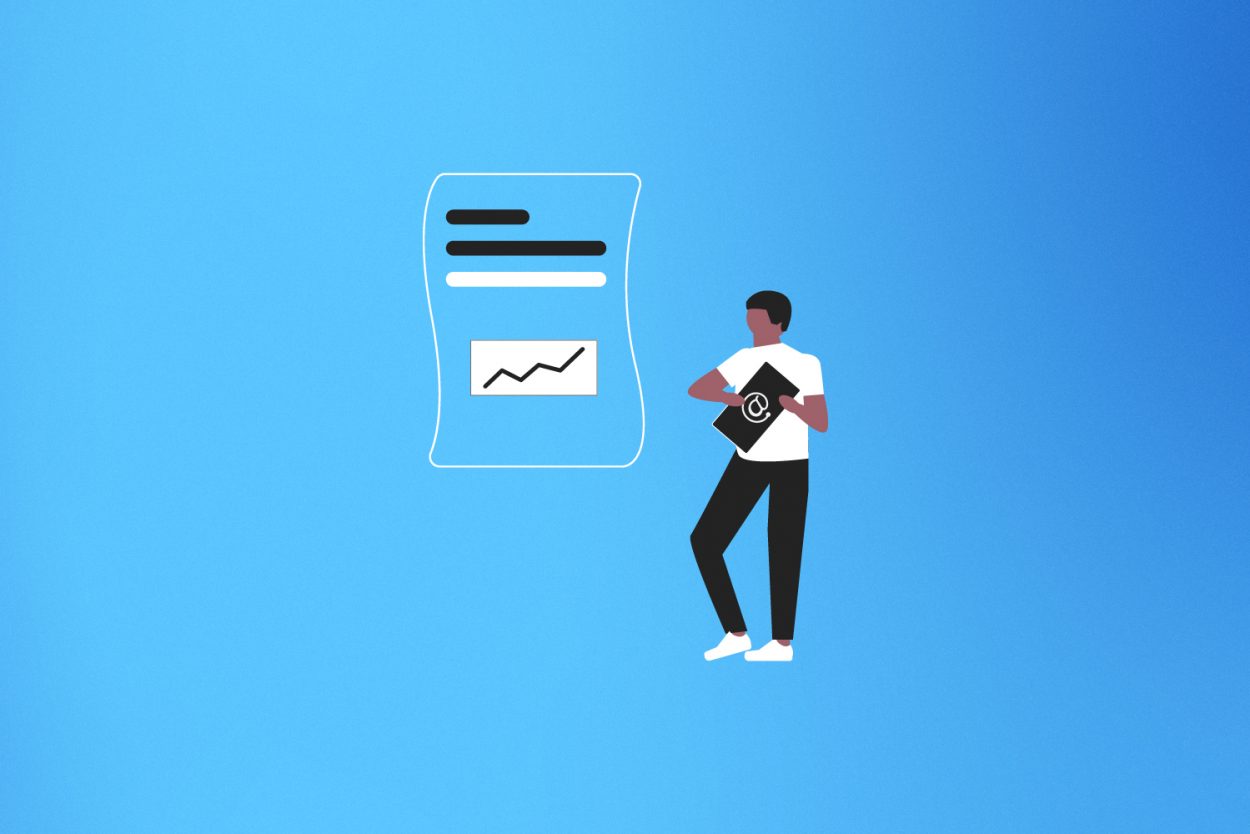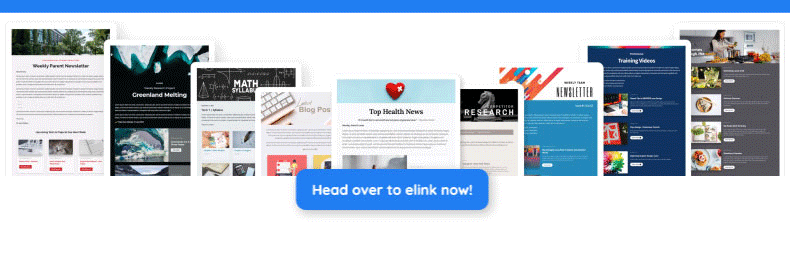📩 An unwanted email is like a knock on the door from someone you’ve never invited—it’s annoying and forgettable.
The truth is, people don’t enjoy opening messages from brands they don’t recognize. And if you’re a business sending emails to people who never asked for them, chances are that they’re hitting either the delete or unsubscribe buttons. That’s why Permission Marketing is a game-changer.
Essentially, permission marketing involves obtaining permission from individuals before sending them emails. Sounds simple, right? But this small step makes a huge difference in how people respond—they’re more likely to open your emails, trust your brand, and eventually make a purchase.
That’s why we’re here with this guide, where you’ll learn exactly what permission marketing is, why it works so well, and how you can start using it today to build an email list that is full of people who actually want to hear from you.
Let’s get started with the basics of permission marketing.
Read More 💡 35+ Email Marketing Best Practices You Need To Know Now
What is Permission Marketing?
Let’s break it down in simple terms for you. Permission marketing is when you ask people before sending them marketing messages—like emails, offers, or updates.
Let’s take a simple example to make you understand better.
Imagine you get a phone call from an unknown number who is trying to pitch you a service you don’t need. Since you didn’t ask for it, your first reaction is to hang up the call. Now imagine a different scenario—you sign up for a cooking class online, and a few days later, they send you helpful tips and a recipe ebook you actually wanted. Feels good, doesn’t it?
That’s the difference. The first is interruption. The second is permission.
So, rather than forcing your message on people who don’t care, you only reach out to those who say, “Yes, I want to hear from you.”
In short, permission marketing is about sending messages to people who actually want them. But why does permission marketing work so well for email growth? Let’s find out.
🚀 Make permission marketing effortless! Use elink.io to create engaging, opt-in newsletters and web content that your audience actually wants to receive.
Why Permission Marketing Works for Email Growth
Let’s be honest—nobody enjoys getting emails from brands that they never signed up for. Such cold emails feel salesy, impersonal, and annoying. However, permission marketing fixes that by focusing on building trust and a real connection with subscribers. Here’s how permission marketing can help your emails get better results: 👇
✅ People Want to Hear from You
When someone signs up for your email, they’re not just giving you their email—they’re permitting you to send them more related emails.
For example, if someone downloads your free ebook or signs up to get updates on your new skincare product, that’s a clear sign: “I like what you’re doing. Keep me in the loop!”
And that’s a big deal. That means you’re not chasing strangers, you’re building a community of people who chose to listen to you. It is even backed by research that 86% of people actually want to receive promotional emails from the businesses they like.
✅ Higher Open and Click Rates
Here’s the truth: when people willingly choose to hear from you, they actually pay attention to your content. That’s the magic of permission marketing.
Studies show that permission-based emails (opt-in) see open rates as high as 37%–42%, while cold or unsolicited emails often struggle to hit even 5%. That’s a massive difference. And higher open rates naturally lead to better click-through rates, more engagement, and better results.
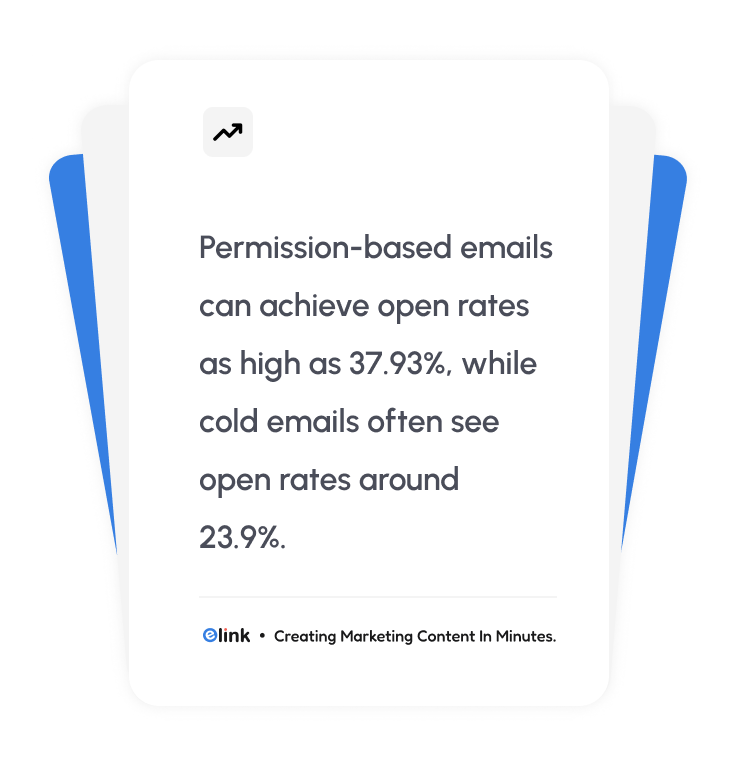
Fun Fact: Did you know that permission-based emails can achieve open rates as high as 37.93%, while cold emails often see open rates around 23.9%?
✅ Fewer Unsubscribes and Spam Complaints
When people get emails they didn’t ask for, they either delete them, unsubscribe, or worse—mark them as spam. But this can hurt the sender’s reputation, and your future emails might go straight to the spam folder, even for people who actually want them!
But with permission marketing, things are different. Your subscribers actually want to hear from you—because they signed up for it. That means fewer complaints and more consistent engagement.
✅ Builds Trust Over Time
Indeed, Email isn’t just a sales tool—it’s a trust-building tool. When you consistently share helpful, relevant content (not just sales pitches), your audience sees you as a brand that truly cares.
Over time, this creates a genuine relationship. And when people trust you, they’re more likely to buy from you, recommend you to others, and keep coming back. For example, a travel brand that sends destination tips, packing guides, and flight deals—not just booking ads—will earn more trust and loyalty than one that only promotes its services.
So, now that you know why permission marketing works, let’s move on to the best practices of permission marketing.
Read More ✨ Email Marketing Stats You Should Know for Your Next Campaign!
Best Practices of Permission Marketing to grow email list
Well, permission marketing is not just about collecting emails—it’s about creating a great experience from the moment someone says “yes” to receive future emails. So, in this section, we’ll discuss the must-follow best practices that will help you grow an email list full of loyal, interested subscribers. Let’s get started.
1. Always Ask for Permission First
Let’s begin with a simple question: would you like getting texts or calls from someone you never gave your mobile number to? Probably not, right? The same goes for emails.
That’s why the first golden rule of permission marketing is very simple: Never send emails without permission. Let people freely choose to sign up.
📊 Quick Fact: A study found that emails from permission-based lists get 2x higher open rates than those sent without clear consent.
2. Keep Sign-up Simple
Now, when people agree to subscribe to you, don’t make them fill out long forms to subscribe to emails. The easier it is to join your email list, the more subscribers you’ll gain—and the better your email campaigns will perform. So, in the sign-up form, you should just ask for what you really need—usually just a name and email.
👉 Pro Tip: Place the sign-up form where it’s easy to see—such as on your homepage, blog, or as a pop-up. You can also embed a landing page created via elink.io directly into your web pages, making the experience seamless and engaging.
3. Offer Valuable Lead Magnets
Honestly, no one subscribes to your email for just salesy messages. If you want people to sign up, give them a reason that feels worth subscribing to your emails.
This is where a lead magnet comes in. A lead magnet is something valuable that you can offer in exchange for their email. Some ideas include:
- A free guide or checklist
- A discount on their first order
- A mini course
- Access to exclusive content
- Or simply a helpful, well-written newsletter
Because people love getting value in exchange for their time and email.
For example: “Subscribe now and get a FREE 5-day skincare routine you can try at home.” This gives clear value and a clear reason to click.
4. Deliver What You Promised (and Keep It Fresh!)
When someone signs up for your emails, they’re basically saying: “Yes, I trust you—send me what you promised.” So it’s your responsibility not to break that trust!
If you told people that they’ll get weekly tips, don’t suddenly flood their inbox with daily promos. That’s the fastest way to lose subscribers. Always make people excited to open your emails. Because when you keep your word that you promised before signing up for the emails, your list will grow, and you connect with more loyal readers.
5. Make It Easy to Unsubscribe
Okay, this might sound a little weird, but letting people unsubscribe easily is actually a good thing. It shows that your brand respects the choice of your subscribers, and you only want those people on your list who actually want to hear from you.
For instance, you can add a simple line at the bottom of your email like: “Don’t want these emails anymore? Click here to unsubscribe anytime. No hard feelings!”
🧠 Tip: A clean list = better open rates, fewer spam complaints, and happier subscribers.
So, by following these best practices of permission marketing, you’ll not only grow your email list, but you’ll also grow a loyal audience that trusts your brand and actually looks forward to hearing from you.
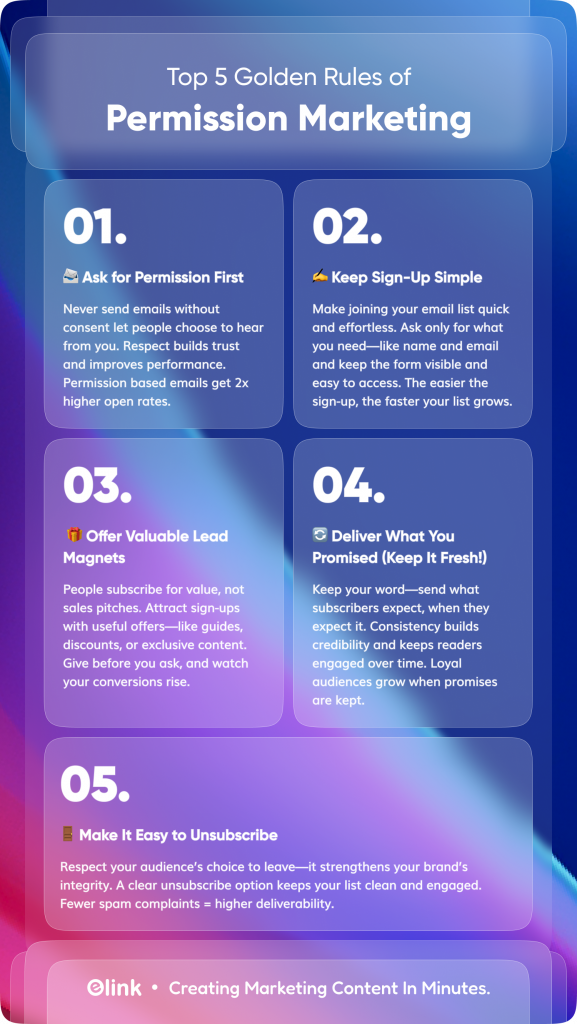
After Permission Marketing What’s Next? Elink.io
Once you have permission, the next step is to deliver fast, engaging newsletters—and that’s where a tool like Elink.io comes in. Elink.io helps you curate, organize, and share content effortlessly, making it simple to create newsletters that look professional on any device. Whether your audience checks Gmail, Outlook, Mailchimp, ActiveCampaign, or nearly any other major email platform, your emails will display perfectly and drive engagement.
Let’s face it, sending amazing emails regularly feels like a daunting task. From designing layouts to adding content and making it all look good, it feels so heavy.
That’s where elink.io is helpful.
Elink.io is the smartest content curation tool that helps you curate, organize, and share content effortlessly. Whether it’s newsletters, email updates, resource hubs, or curated collections for your audience, Elink makes it easy to deliver professional, polished content—without needing any design skills. Now, creating content that your subscribers actually want to see is simple, fast, and stress-free with elink.io.
Here’s what makes Elink.io a smart choice for permission marketing:
✅ Create Stunning Newsletters in Minutes: Do you have a bunch of links to blogs, videos, product pages, or anything online? You just have to copy them into Elink, and boom, it converts them into a gorgeous newsletter instantly.
✅ Use Ready-to-Go Templates: With Elink, you don’t need to begin from scratch. Elink has dozens of sleek, mobile-friendly templates available that you can customize in seconds. Simply insert your content, adjust the colors or text if desired, and you’re ready.
✅ Automate Your Content with RSS: Do you want to auto-send fresh content? You just have to integrate your blog RSS feed, and Elink will automatically update your webpages whenever you post another piece of content.
✅ Embed your curated content anywhere: You can embed your curated content directly into your website, blog, or emails. This means that your audience gets seamless access to your resources.
✅ Smooth Integrations with third-party apps: You can send your newsletters via Gmail, Mailchimp, ActiveCampaign, Constant Contact, or any other platform you already use directly from the Elink dashboard.
✅ Smart Analytics Built In: Want to see how your newsletters are doing? Elink measures views, clicks, and engagement—so you can know what’s working and continue improving.
So, permission-based marketing is most effective when your emails are pretty and deliver real value, and Elink.io makes it easy to do so. Why wait? Start using Elink today!
Wrapping It Up
At the end of the day, people don’t want to be sold to; they want to be helped. And that’s what permission marketing is all about.
When someone gives you their email, they’re trusting you to deliver something of value. And when you respect that trust, amazing things happen—more opens, more clicks, fewer unsubscribes, and a genuine connection with your audience.
And if you’re looking to make your email game smoother (and stronger!), don’t forget tools like Elink. Elink can help you save time and make your emails look professional without ever needing design capabilities.
Ready to grow your list with trust and purpose? Start using permission marketing today, and your audience (and your inbox results) will thank you later!
FAQs
Q1. What is permission-based marketing?
Permission-based marketing means that you only send emails to people who have agreed to hear from your brand. For example, someone joins your email list by filling out a form or clicking “subscribe.” This shows they want to hear from you. So, instead of sending random emails to strangers, you only message those people who have permitted you.
Q2. How does permission marketing improve email deliverability?
When people actually want your emails, they’re less likely to delete them or mark them as spam. This tells email platforms (like Gmail or Outlook) that you’re a trusted sender, which helps your emails land in the inbox—not the junk folder.
Q3. Why is permission marketing better than traditional email tactics?
Traditional email marketing often blasts messages to random people. That annoys them and doesn’t work well.
But with permission marketing, your audience is already interested in hearing from you. So they’re more likely to open, read, and act on your emails. It’s a more effective and respectful way of marketing.
Q4. What kind of content works best in permission marketing emails?
Homestly, the best content is what your audience actually wants! You can send helpful tips, how-tos, special offers, updates, or resources related to what they signed up for.
For example, if someone signs up for fitness tips, send them quick workouts, healthy recipes, or motivation—not random sales emails.
Q5. How do I grow an email list using permission marketing principles?
You just have to keep things simple and make people want to sign up for your emails. You can go with these strategies:
- Give something valuable in return—like a free guide, discount, checklist, or helpful tips.
- Add sign-up forms on your website, blog, or social media so people can easily find and join.
- Tell them what they’ll get—like weekly tips, product updates, or special offers. When people know what to expect, they’re more likely to trust you and stay on your list.
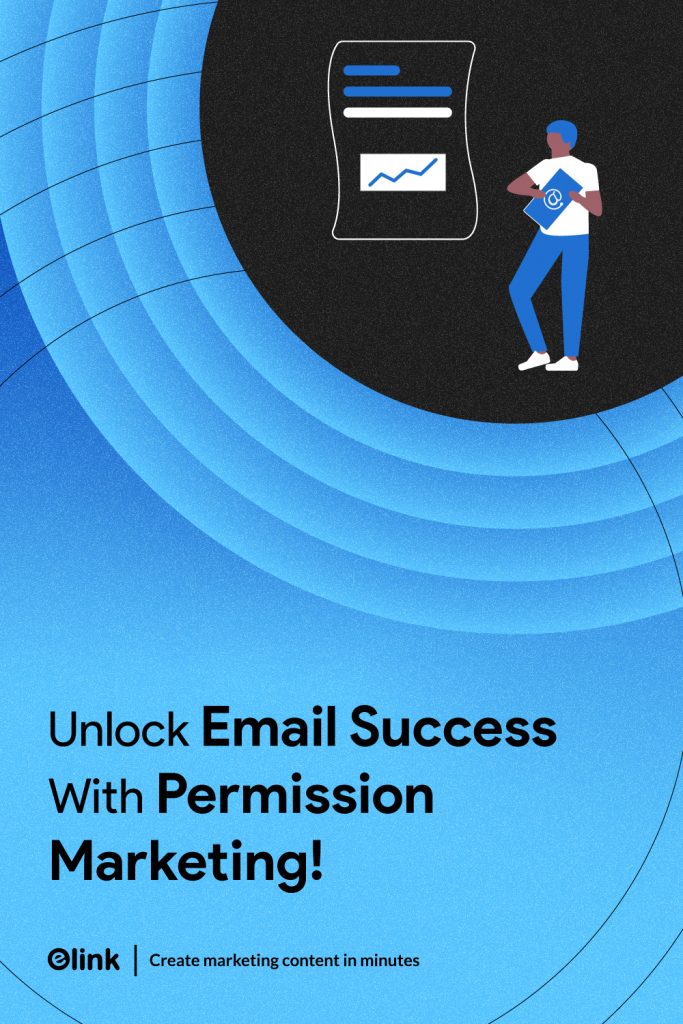
Keep Reading & Learning 📚
How to Create a Monthly Newsletter for Business: (Tips & Steps)
Reduce Email Bounce Rates Using These 11 Tried & Tested Methods!
SaaS Email Marketing: How to Boost Engagement and Conversions?

